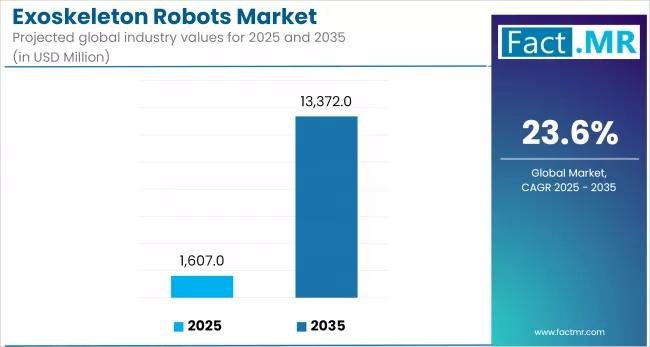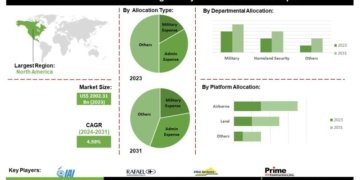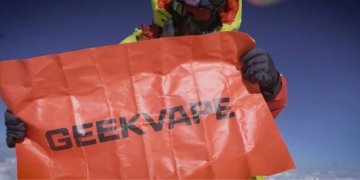The global Exoskeleton Robots Market, valued at US$ 1,331 million in 2024, is projected to reach US$ 13,372 million by 2035, driven by a robust CAGR of 23.6%. Fueled by advancements in robotics, increasing demand for rehabilitation and industrial applications, and supportive government initiatives, this market is transforming healthcare, manufacturing, and defense sectors. This press release explores the key drivers, projections, and opportunities shaping this dynamic industry.
For More Insights into the Market, Request a Sample of this Report: https://www.factmr.com/connectus/sample?flag=S&rep_id=7935
Why Is the Market Growing?
The rising prevalence of mobility impairments, with 15% of the global population living with disabilities in 2024, drives demand for exoskeleton robots in rehabilitation, particularly for stroke and spinal cord injury patients. Industrial applications, with a 20% increase in workplace ergonomic solutions in 2024, boost adoption for reducing worker fatigue and injuries.
Innovations like Ekso Bionics’ 2024 lightweight exoskeleton for rehabilitation and Sarcos Robotics’ Guardian XO for industrial tasks enhance functionality. Government funding, such as the U.S.’s US$ 100 million DARPA program for exoskeletons, supports growth, while high costs, averaging US$ 50,000 per unit, are mitigated by rental models and scalable production.
What Are the Key Market Projections?
The market is set to create a US$ 12,041 million opportunity by 2035, growing from US$ 1,331 million in 2024 to US$ 13,372 million at a 23.6% CAGR. The healthcare segment, holding a 50% share in 2024, is projected to grow at a 24.0% CAGR, creating a US$ 6,700 million opportunity.
North America, with a 40% share in 2024, leads due to advanced healthcare infrastructure, while Asia-Pacific grows at a 25% CAGR, driven by Japan and China’s aging populations. Historical growth from 2019 to 2023 was at a 15% CAGR, indicating an accelerating trend. Short-term growth (2025-2028) focuses on rehabilitation, while long-term trends (2030-2035) emphasize industrial and military applications.
How Can Stakeholders Leverage Opportunities?
Stakeholders in healthcare, manufacturing, and defense can capitalize by investing in lightweight and AI-enabled exoskeletons, like ReWalk Robotics’ 2024 soft exosuits for mobility assistance. Partnerships, such as Cyberdyne’s 2023 collaboration with Japanese hospitals, enhance market reach.
Targeting North America, with a projected US$ 5 billion market by 2030, and Asia-Pacific, with Japan’s aging population, offers significant potential. Rental and subscription models, accounting for 20% of sales in 2024, ensure scalability. Compliance with FDA and ISO 13485 standards boosts market trust and competitiveness.
What Does the Report Cover?
Fact.MR’s report combines primary research with experts across 30+ countries and secondary analysis, covering segments by mobility (mobile, fixed), technology (powered, passive), end user (healthcare, industrial, defense, others), and region (North America, Latin America, Europe, East Asia, South Asia & Oceania, Middle East & Africa). It highlights trends like AI integration, soft exosuits, and ergonomic designs, providing actionable insights for stakeholders.
Browse Full Report: https://www.factmr.com/report/exoskeleton-robots-market
Who Are the Market Leaders?
Key players include Ekso Bionics, ReWalk Robotics, Cyberdyne, Sarcos Robotics, and Ottobock. Ekso Bionics’ 2024 lightweight exoskeleton launch improved patient mobility by 20%, while Sarcos’ Guardian XO enhanced industrial productivity in 2023. These companies, holding over 45% of the market, drive innovation through R&D and partnerships with healthcare and industrial sectors.
What Are the Latest Market Developments?
In 2024, global rehabilitation device demand grew by 10%, with exoskeletons accounting for 30% of assistive technology sales. AI-enabled exoskeletons, adopted by 15% of manufacturers, improved user adaptability by 25%. North America’s 40% share reflects robust R&D funding, while Asia-Pacific’s growth is driven by Japan’s 20% elderly population. Regulatory advancements, like the FDA’s 2024 approval of soft exosuits, increased adoption by 12%. Developments such as Ottobock’s 2024 modular exoskeleton enhanced versatility across healthcare and industrial applications.
What Challenges and Solutions Exist?
High costs, averaging US$ 50,000 per unit, and regulatory complexities, with 20% of devices delayed by approvals, pose challenges. Limited awareness in developing regions, with 10% penetration, hinders growth. Solutions include rental models, reducing costs by 20%, and modular designs, like Cyberdyne’s 2024 systems, enhancing affordability. Localized production in Asia-Pacific, adopted by 15% of manufacturers, mitigates supply chain risks. Compliance with global safety standards ensures market resilience and user confidence.
Conclusion:
The Global Exoskeleton Robots Market is set to reach US$ 13,372 million by 2035, driven by a 23.6% CAGR. With applications in healthcare, industrial, and defense sectors, and supported by AI and lightweight innovations, the market offers transformative opportunities. Stakeholders can leverage Fact.MR’s insights to target high-growth regions like North America and Asia-Pacific, invest in advanced solutions, and address cost and regulatory challenges to thrive in this dynamic industry.
Check out More Related Studies Published by Fact.MR:
Wearable Cardiac Monitors Market: https://www.factmr.com/report/3970/wearable-cardiac-monitors-market
Motor Starters Market: https://www.factmr.com/report/3568/motor-starters-market
Magnetic Grippers Market: https://www.factmr.com/report/4164/magnetic-grippers-market
Grader Machinery Market: https://www.factmr.com/report/grader-machinery-market
Contact:
US Sales Office
11140 Rockville Pike
Suite 400
Rockville, MD 20852
United States
Tel: +1 (628) 251-1583, +353-1-4434-232
Email: sales@factmr.com
About Fact.MR
We are a trusted research partner of 80% of fortune 1000 companies across the globe. We are consistently growing in the field of market research with more than 1000 reports published every year. The dedicated team of 400-plus analysts and consultants is committed to achieving the utmost level of our client’s satisfaction.
This release was published on openPR.


















